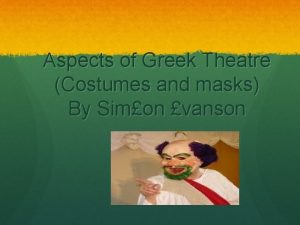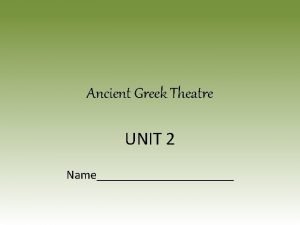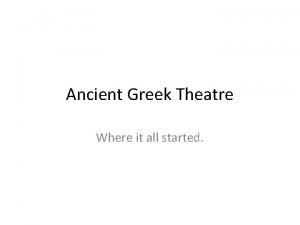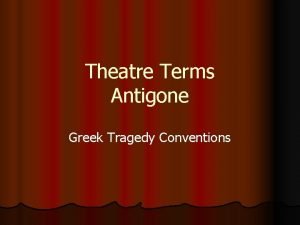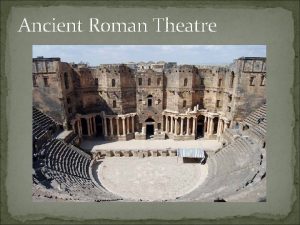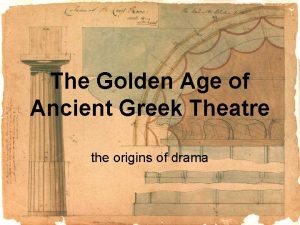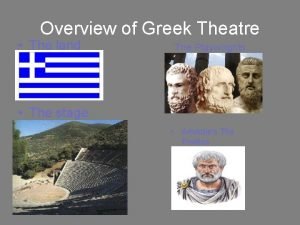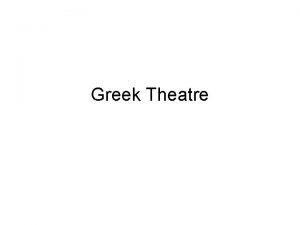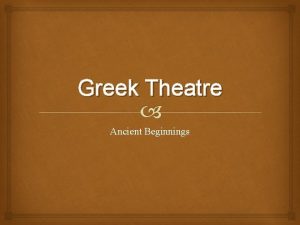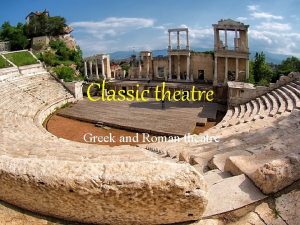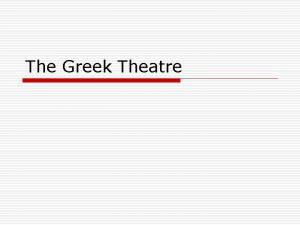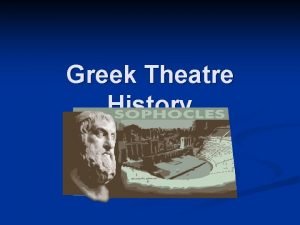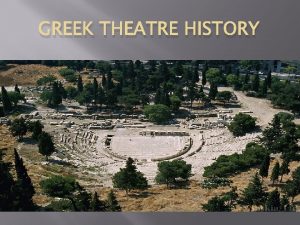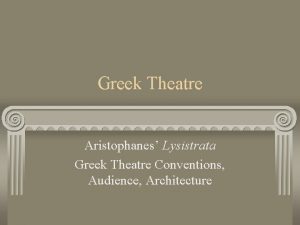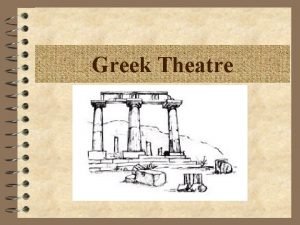HISTORY I In ancient Greek theatre the conventional













- Slides: 13


HISTORY I • In ancient Greek theatre the conventional three actor rule was preceded by a two actor rule, which was itself preceded by a convention in which only a single actor would appear on stage, accompanied by the chorus. • The origin of the monologue as a dramatic device, therefore, is not rooted in dialogue. It is, instead, the other way around; dialogue evolved from monologue.

HISTORY II • Ancient Roman theatre featured monologues extensively, more often than either Ancient Greek theatre or modern theatre. • One of the key purposes of these monologues was to indicate the passage of significant amounts of time (that would be tedious to actually play out in real time) within scenes. • This type of monologue is referred to as a linking monologue. • Other monologue types included "entrance monologues“ and exit monologues. In each of these cases a primary function is indicating the passage of time.

HISTORY III • From Renaissance theatre onward, monologues generally focused on characters using the extended speech to pursue their dramatic need. • Postmodern theatre, on the other hand, often embraces the performative aspects of the monologue, even to the point of challenging the boundary between character portrayal (e. g. acting) and autobiographical speeches.

MONOLOGUES • In theatre, a monologue is presented by a single character, most often to express their mental thoughts aloud, though sometimes also to directly address another character or the audience. • Monologues are common across the range of dramatic media (plays, films, etc. ) as well as in non-dramatic media such as poetry. • Monologues share much in common with several other literary devices including soliloquies, apostrophes, and aside. There are, however, distinctions between each of these devices.

A Monologue’s Cousins • Monologues are similar to soliloquies, epiphanies, and asides. Nevertheless, meaningful differences exist among them. • A monologue is distinct soliloquy because the latter involves a character relating his or her thoughts and feelings to him/herself and to the audience without addressing any of the other characters. • A monologue is the thoughts of a person spoken out loud. Monologues are also distinct from apostrophes, wherein the speaker or writer addresses an imaginary person, inanimate object, or idea. • Asides differ from each of these not only in terms of length (asides being shorter) but also in that asides aren't heard by other characters even in situations where they logically should be (i. e. two characters engaging in a dialogue interrupted by one of them delivering an aside).

TYPES OF MONOLOGUES • Interior monologues involve a character externalizing their thoughts so that the audience can witness experiences that would otherwise be mostly internal. • In contrast, a dramatic monologue involves one character speaking to another character. • Monologues can also be divided along the lines of active and narrative monologues. In an active monologue a character is using their speech to achieve a clear goal. Narrative monologues simply involve a character telling a story and can often be identified by the fact that they are in the past tense.

• Macbeth's monologue Tomorrow and tomorrow after he learns that Lady Macbeth has killed herself: » She should have died hereafter; There would have been a time for such a word. Tomorrow, and tomorrow, Creeps in this petty pace from day to day, To the last syllable of recorded time; And all our yesterdays have lighted fools The way to dusty death. Out, out, brief candle! Life's but a walking shadow, a poor player That struts and frets his hour upon the stage And then is heard no more. It is a tale Told by an idiot, full of sound and fury Signifying nothing. » — Macbeth (Act 5, Scene 5, lines 17 -28)

AUDITION MONOLOGUE • Theatre actors may be called upon to use monologues for audition purposes. • Audition monologues demonstrate an actor's ability to prepare a piece and deliver a performance. • These pieces are usually relegated to two minutes (sometimes less) and are often paired with a contrasting monologue. • This can be a comic monologue paired with a dramatic monologue or it can mean classical paired with contemporary. • The choice of monologues for an audition can often depend on the play in question or the role the actor wants to land. The audition monologue is a rite of passage with theatre actors and a tradition that continues today.

TYPES OF MONOLOGUES • Interior monologues involve a character externalizing their thoughts so that the audience can witness experiences that would otherwise be mostly internal. • In contrast, a dramatic monologue involves one character speaking to another character. • Monologues can also be divided along the lines of active and narrative monologues. In an active monologue a character is using their speech to achieve a clear goal. Narrative monologues simply involve a character telling a story and can often be identified by the fact that they are in the past tense.

• MONOLOGUES READING – Description of the character – The Situation the person find themselves in within the monologue • YOU JOB ON A PIECE OF LOOSE LEAF IS TO: 1. 2. 3. 4. Write down the title of any TEN (10) Monologues and the play it is from. Determine, in your best estimate based on the monologue if it is an Interior monologue, dramatic monologue, active monologue, or Narrative monologues. Write down, in your opinion, what you think the monologues are about (3 -5 sentences tops) Give your impression of the character giving the monologue.

• The Belle of Amherst by William Luce (1978) • Interior Monologue • Describing her life as a shut in. She is also giving a glance of what her life is like overall and her attitudes towards other people. The monologue is setting up what could be conflict in the play based on the character's attitude. • Impression of the character: strong willed, sassy, very determined to live her life based on the rules she set out for herself.

• Stuart Mc. Lean is a Canadian radio broadcaster, humourist, monologist, and author, best known as the host of the CBC Radio program The Vinyl Cafe. He is often described as a "story-telling comic", though he has written many serious stories. He is known for his distinctive voice and his ability to alter his popular stories to make them distinctive on every show. • A monologist is a solo artist who recites or gives dramatic readings from a monologue, soliloquy, poetry, or work of literature for the entertainment of an audience. The term can also apply (often disparagingly) to one who dominates a conversation, or to a bird with a repeating monotonous cry.
 Greek drama origin
Greek drama origin Greek costumes in theatre
Greek costumes in theatre Greek theatre stage diagram
Greek theatre stage diagram Greek theatre masks
Greek theatre masks Skene definition theatre
Skene definition theatre Ancient greek theatre architecture
Ancient greek theatre architecture Greek theatre conventions
Greek theatre conventions Greek theater masks
Greek theater masks Ancient rome theater
Ancient rome theater Greek drama history
Greek drama history Ancient and modern communication
Ancient and modern communication Ancient india vs ancient china
Ancient india vs ancient china The word theater comes from greek and literally
The word theater comes from greek and literally Greek theater playwrights
Greek theater playwrights

